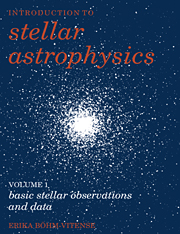Book contents
- Frontmatter
- Contents
- Preface
- 1 Positions of stars
- 2 Proper motions of stars
- 3 Distances of nearby stars
- 4 The brightnesses of the stars
- 5 Color magnitude diagrams
- 6 The luminosities of the stars
- 7 Angular radii of stars
- 8 Effective temperatures of stars
- 9 Masses and radii of stars
- 10 Spectral classification
- 11 Understanding stellar spectra
- 12 Population II stars
- 13 Stellar rotation
- 14 Stellar magnetic fields
- 15 Stars with peculiar spectra
- 16 Pulsating stars
- 17 Explosive stars
- 18 Our sun
- 19 Interstellar absorption
- Appendixes
- References
- Index
14 - Stellar magnetic fields
Published online by Cambridge University Press: 04 August 2010
- Frontmatter
- Contents
- Preface
- 1 Positions of stars
- 2 Proper motions of stars
- 3 Distances of nearby stars
- 4 The brightnesses of the stars
- 5 Color magnitude diagrams
- 6 The luminosities of the stars
- 7 Angular radii of stars
- 8 Effective temperatures of stars
- 9 Masses and radii of stars
- 10 Spectral classification
- 11 Understanding stellar spectra
- 12 Population II stars
- 13 Stellar rotation
- 14 Stellar magnetic fields
- 15 Stars with peculiar spectra
- 16 Pulsating stars
- 17 Explosive stars
- 18 Our sun
- 19 Interstellar absorption
- Appendixes
- References
- Index
Summary
General discussion
We are all accustomed to the fact that our Earth has a magnetic field whose shape comes rather close to that of a dipole field, with the magnetic axis not being very different from the rotational axis of the Earth. This raises the suspicion that the magnetism is due or at least related to the rotation of the Earth. We may therefore wonder whether stars which have much higher rotational velocities than the Earth might have much stronger magnetic fields than the Earth. It seems very interesting to check. The question arises: how can we measure magnetic fields on stars? We clearly cannot take a magnetometer to the star's surface. All we can get from the star is its light. Fortunately, nature has provided an effect of a magnetic field on the light which can be used to measure magnetic fields of stars. This is the Zeeman effect, named after its discoverer.
The Zeeman effect
Zeeman discovered that for a laboratory light source which emits an emission line spectrum in a laboratory magnetic field, the spectral lines generally split into several components. If you observe the light in an arbitrary direction with respect to the direction of the magnetic field, you will, in the simplest case, see a line split into three components, the socalled Lorentz triplet. The central component remains at the original wavelength λ0, which the line had without a magnetic field.
- Type
- Chapter
- Information
- Introduction to Stellar Astrophysics , pp. 117 - 126Publisher: Cambridge University PressPrint publication year: 1989

